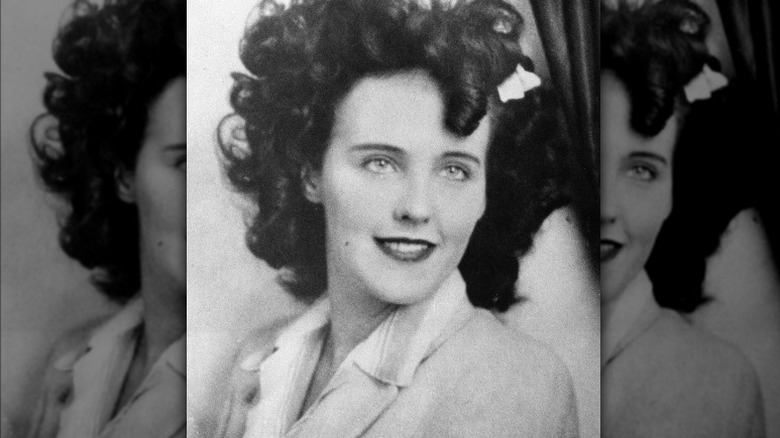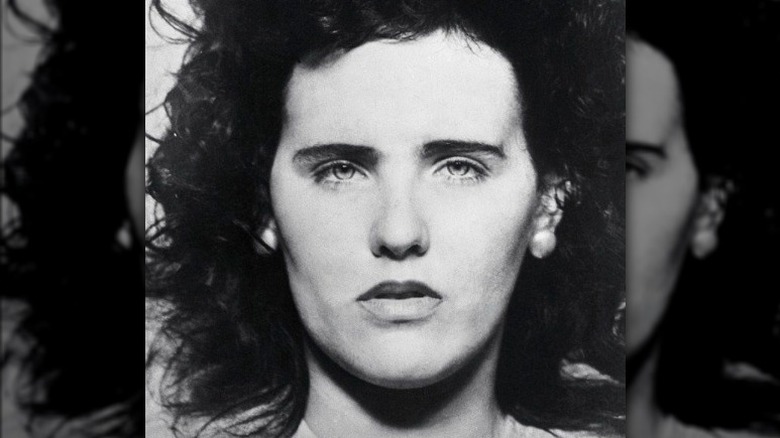The Truly Horrific Crime Scene Of The Black Dahlia
The following article includes graphic details of fatal violence and assault.
The human fascination with murder is as old as murder itself. And we don't mean basic, repeated questions like, "How could someone do this?" We mean murders' most grisly details. Ancient, classic literature like "The Iliad" — written down from the eighth to seventh century B.C.E. — describes gory spear battles like, "It went crashing in among his white teeth; the bronze point cut through the root of his tongue, coming out under his chin, and his glistening armor rang rattling round him as he fell heavily to the ground." The 15th century gave us child serial killer Gilles de Rais, who kissed the severed heads of his victims (per All That's Interesting), while the 20th century gave us Ed Gein, who made lamps out of human skin (also per All That's Interesting). The list goes on and on.
This is why it's so surprising that the "Black Dahlia" murder has stayed with us for nearly 75 years. It was one murder on one day, and it's still shocking: the cruel, perverse ritualism; the abuse unleashed on the victim's corpse; and the nigh-blasphemous measures that the murderer very deliberately employed. Chances are you've heard of the murder, even if you've been spared the details. The case's distinctive name, plus a well-timed movie release — 1946's "The Blue Dahlia," about a man suspected of murdering his wife, who had cheated on him — helped make the Black Dahlia famous, per the BBC. And to this day, the crime remains unsolved.
Mutilated and tortured in profane ways
As the BBC describes, Elizabeth Short was a petite, would-be Hollywood starlet with short, curly black hair. On January 8, 1947, she returned to the glamorous Biltmore Hotel in Los Angeles. Her body was discovered one week later — parts of it, at least — and a media circus ensued. Police interrogated over 50 suspects, but no one was charged. Short became a victim and cautionary tale rolled into one, the "sad cliché" of a young woman devoured by Hollywood dreams.
Betty Bersinger and her daughter discovered Short in Leimert Park east of Crenshaw. Bersinger spotted what she thought was two halves of a mannequin, but it was actually the victim, spread eagle on the ground. Short's spine had been severed at the waist above the hips, "the only spot where the body can be severed in half without breaking bone," as The Guardian says. Her stomach contained feces that she'd been forced to eat leading up to her death. Medium states that her genitals had been mutilated, and her anus dilated as though sodomized. Her own carved flesh had been inserted into her vagina and rectum along with pubic hair. Her right breast had been cut off, and she'd been given a Glasgow smile — lips cut from the corners to the ears. Her uterus had also been completely removed. Finally, she'd been washed and cleaned so that there wasn't a drop of blood anywhere. There were no traces of semen.
Injuries sustained before and after death
Medium provides us with further details about the Black Dahlia murder and its victim, Elizabeth Short. Many of these details come from Michael Newton's 2009 book, "The Encyclopedia of Unsolved Crimes," which lists the details of over 800 crimes and their victims' autopsies.
We know, for instance, that Short was alive when she sustained certain injuries. The Glasgow smile, for instance, was surrounded by bluish discoloration and displayed evidence of ecchymosis, a type of internal bleeding caused by extreme pressure applied to living tissue, as Osmosis explains. In addition to this, she'd sustained a blow on the right side of the head that had rebounded on impact and caused further hemorrhaging in her brain. It's likely that this was her actual cause of death. Short could have lived through certain mutilation, like having a breast cut off, and not died. It stands to reason that other forms of dismemberment, like being cut in half at the waist, likely happened after she died.
Because of the extremely precise nature of the mutilation and injuries, some believe that Short was killed by someone with practice, like a serial killer who went undetected before and after the crime. Some think that it would have taken a medical professional or medical student, complete with medical equipment, to make such clean incisions across Short's body. Either way, the murder would have had to occur inside and with access to adequate water and drainage.
Details from the crime scene
For the strong-stomached, there are photos available online for respectful investigation of the actual Black Dahlia crime scene. Sites like Reel Reviews, Horror History, and Forensic Science Society show overall crime scene shots and close-ups of Elizabeth Short's body, police kneeling nearby and gazing at Short, other police standing on the sidewalk near the scene and talking, onlookers gathered in the street, you name it. Judging by the photos, it's easy to see why Betty Bersinger, the lady who discovered Short, thought she'd seen a mannequin. It's also easy to see why someone would think that a medical professional was the murderer — the cuts look oddly, even surgically, precise. The location of the body also stands out. It's right next to the sidewalk, as though the murderer wanted Short to be found, or was proud of what had been done.
Actual newspaper headlines from the time, such as that of The Boston Post, capture the shock and sensationalism of the murder; this is before the case had received its "Black Dahlia" moniker. The headline on Rare Newspapers reads, "Savagely Attacked and Beaten Before Death — Discover Body Dismembered, Left in Field," with "West Coast Infuriated By Crime — Move to Post Reward of $10,000 to Find Murderer" written underneath. When combined with photos of the actual crime scene, these newspapers drive home the horrible, depraved reality of not only Elizabeth Short's murder, but any descriptions of death that have come to fascinate people over time.



